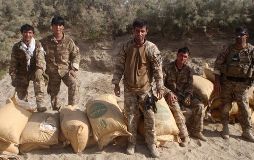 |
|
Members of the elite counterterrorism unit BOST 170 pose next to sacks of calcium ammonium nitrate following a successful heliborne raid against an insurgent explosives cache in the Lashkar Gah district of Helmand. Photo: UK Ministry of Defense. |
Members of an elite counterterrorism unit of the Afghan National Directorate of Security (NDS) called BOST 170 raided an insurgent explosive cache in the Lashkar Gah district of Helmand province on Aug. 21 and seized the largest amount of homemade explosive precursors in the area since 2006. Lashkar Gah district is one of several regions for which NATO transitioned security responsibility to the Afghan government and security forces in May.
Some 60 soldiers from BOST 170 helped conduct the heliborne operation that confiscated over four tons of ammonium nitrate fertilizer, the key ingredient in over 80% of the main charges found in improvised explosive devices (IEDs) in Afghanistan. The sacks of prohibited fertilizer were destroyed in place with assistance from Task Force Helmand’s Brigade Reconnaissance Force (BRF) demolition team.
NATO assisted with the creation of the elite BOST 170 counterterrorism unit in 2008 to help conduct reconnaissance, interdiction, and seizure operations.
The Helmand provincial governor released a statement on the recent raid and quoted NDS head General Nazar Ali Wahidy, who said: “These explosives were skillfully kept beside undergrowth and terrorists wanted to make IEDs from them and use them in different sorts of attacks. The NDS of Helmand discovered the ammonium nitrate parcels which could have made IEDs. By discovering and removing the explosives, the NDS stopped a big disaster.”
The commando raid against the explosives cache highlights the continuing battle against the IED threat. From April to June this year, 3,845 IEDs exploded or were found, according to the Pentagon’s Joint IED Defeat Organization (JIEDDO). The numbers of Coalition forces killed and wounded in IED attacks rose 15 percent between April and June compared to the same time frame last year. In June, the usage of IEDs was 25 percent higher than average.
The area of operations where BOST 170 seized the explosives cache remains one of the worst-affected parts of Afghanistan. The type of explosive precursors seized, ammonium nitrate, continues to plague security forces throughout Afghanistan. Irene Smith, spokeswoman for JIEDDO said: “During the last 12 months, an unending supply of calcium ammonium nitrate, originating almost exclusively from Pakistan, has been used to produce IEDs in Afghanistan despite a countrywide ban.”
On July 30, a minivan carrying civilians from Lashkar Gah to the adjacent district of Nahri-Saraj struck an insurgent-planted IED, killing 16 Afghans and wounding several others. On August 13, another insurgent-planted IED killed five civilians traveling through the same area, according to local authorities. The Taliban did not take responsibility for either attack, but they rarely admit to attacks that kill civilians. In both instances, the bombs were placed on the roadway overnight and were detonated by early morning road traffic.
Lastly, on August 18, an IED destroyed a minibus carrying Afghan civilians through the western province of Herat. At least 22 men, women, and children perished in the blast, which local authorities blamed on Taliban insurgents. The previous year, a similar IED attack in the same area of the Obe district killed 14 civilians.
Are you a dedicated reader of FDD's Long War Journal? Has our research benefitted you or your team over the years? Support our independent reporting and analysis today by considering a one-time or monthly donation. Thanks for reading! You can make a tax-deductible donation here.








4 Comments
A cache is still a just a cache. It must have been a confidence target for a “elite” commando team.
Keep up the good work guys!
Ejaz
This is great news. Not only does it demonstrate that the ANA are a capable fighting force (its elite troops at least) and have men who have the capability and will to take the fight to these bomb makers but also takes a lot of potential IEDs of the streets.
They captured ‘over four tons of ammonium nitrate fertilizer’ I wonder does anyone know how much would usually be used in a standard IED device, in other words how many potential bombs would this stock pile have made?
This is great, good news. I think at this point ISAF is well ahead of task in bringing the Afghan forces to top notch ability of securing the land and fighting the various criminal/insurgent threats that are still there.
But unless government corruption and safe havens are dealt with, unfortunately, I regret to say it but this could all end up being a flash in the pan…. we’ll see.